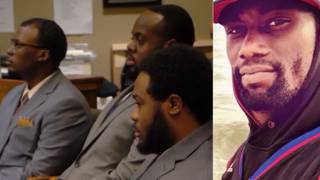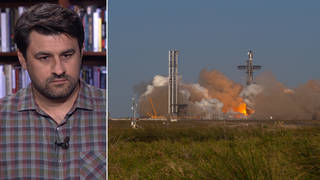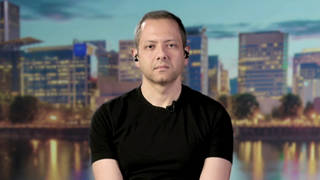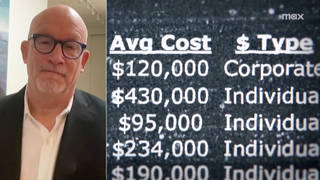
In December 2003, Department of Homeland Security Secretary Tom Ridge warned of “near-term attacks that could either rival or exceed what we experienced on September 11.” He claimed the information came from “credible sources.” But a new report in the latest issue of Playboy by investigative journalist Aram Roston shows that the source was a man who convinced the military and the Bush administration that the TV network Al Jazeera was transmitting secret messages to al-Qaeda sleepers. [includes rush transcript]
Transcript
AMY GOODMAN: We turn now to a story that reveals the real source behind the Bush administration’s decision to raise the terror alert level to “orange” six years ago. It was December 2003. Department of Homeland Security Secretary Tom Ridge warned of, quote, “near-term attacks that could either rival or exceed what we experienced on September 11.” He claimed the information came from “credible sources.”
But a new report in the latest issue of Playboy magazine by investigative journalist Aram Roston shows that the source was a man who convinced the Bush White House, the CIA, the Navy, Special Forces Command, the Air Force, and the Senate Intelligence Committee that the TV network Al Jazeera was transmitting secret messages to al-Qaeda sleepers. Dennis Montgomery operated a small software company out of Nevada. He said he could predict terrorist attacks by decrypting secret bar codes hidden in Al Jazeera’s broadcast. The Bush administration relied on Montgomery for years to determine when to increase the terror threat level.
Well, I recently interviewed journalist Aram Roston, author of The Man Who Pushed America to War: The Extraordinary Life, Adventures, and Obsessions of Ahmad Chalabi
. His article is called “The Man Who Conned the Pentagon.” I began by asking him just to explain the story.
ARAM ROSTON: It was one of the most bizarre intelligence operations I’ve ever heard of. A man who was not necessarily a scientist, but he was a self-proclaimed scientist and a self-proclaimed inventor, he claimed he had found these secret messages. He basically — he claimed he decoded al-Qaeda’s secret communications to sleeper terrorists around the world. And he was doing this in this warehouse in Nevada on his computer.
People in the administration took him seriously, and people in the intelligence services took him seriously. Not everybody. Some people thought this was complete nonsense, because it was. But enough people took him seriously that it had immense effects on people across the world and in America.
AMY GOODMAN: Well, first of all, let’s go to that moment when the terror alert was raised. It was almost exactly six years ago, right? December 21st, 2003, raised to orange. Why?
ARAM ROSTON: This fellow, Dennis Montgomery —-
AMY GOODMAN: And who is he?
ARAM ROSTON: He is a self-proclaimed scientist. He doesn’t have much of a scientific education. He had a two-year degree in medical technology, and he was an inventor and a self-proclaimed computer programmer. I don’t know how many -— how much skills he has as a software programmer. But he said that in Al Jazeera he was finding these hidden numbers shaped as bar codes.
AMY GOODMAN: Who was he telling this to?
ARAM ROSTON: He had access to the intelligence services, to a division within the CIA called Science and Technology. And he had that through political contacts that his financier had.
AMY GOODMAN: And his financier was?
ARAM ROSTON: His financier was a former aide of the former right-hand man to Michael Milken, the disgraced junk bond king, of all things.
AMY GOODMAN: From many years ago.
ARAM ROSTON: Yeah.
AMY GOODMAN: He went to prison.
ARAM ROSTON: Michael Milken went to prison. Now, the fellow who was financing Dennis Montgomery, Warren Trepp, he never went to prison. The SEC went after him, but never successfully.
AMY GOODMAN: And how did he get these contracts? And what exactly did he say? I mean, explain what you’re saying, because, I mean, this is not just the crazy fantasizing of one guy. You have Donald Rumsfeld, the Secretary of Defense, talking about, you know, Al Jazeera being a terrorist network.
ARAM ROSTON: That’s very true. So people were — people saw Al Jazeera in this light, this negative light. The administration did already, perhaps. But what he was saying is it had no — it didn’t matter what the content was. He was saying in the electronic feed from Al Jazeera, there was little secret bits of information injected in it technologically, just little technologic — little bits and so forth. Perhaps the pixels were rearranged. And he was able to decode it all. He was able to decode it all and translate it into numbers.
Those numbers, he said, were latitudes and longitudes. In other words, it was a stream of video, and he was finding these latitudes and longitudes, times, flight numbers. And he would just churn that out. As he would call it, “This is my output.” This is the Al Jazeera output. And he had figured out a way that somehow Al Jazeera was al-Qaeda’s method of transmitting this data secretly. What it would have required, of course, is all these terrorists around the world to have some sort of decoding equipment that could have unscrambled it, which was, I think —-
AMY GOODMAN: And these longitudes and latitudes were supposedly of attacks?
ARAM ROSTON: Yeah. Sometimes it wasn’t even a latitude and longitude; sometimes it was just a latitude, just one number. And he was like, “It’s somewhere around here.” And he would just work and say, “It’s here.” And then, you know, you’d have scares like Tappahannock, Virginia was one place, a little town of Virginia, or, you know, somewhere in Seattle or Galveston, Texas, near the fuel tanks. And they would react.
AMY GOODMAN: And they would cancel planes, for example, around the holidays, like the French airlines.
ARAM ROSTON: Yeah, that was -—
AMY GOODMAN: Air France.
ARAM ROSTON: Exactly. That was one particular period, when they took him — for some reason, he was taken very seriously. It was during that orange alert. And he was the source for all those numbers that were — those flights that were — he was the reason those flights were canceled.
Nobody — most people in the administration didn’t even know where it was coming from. Only a tiny group knew of Dennis Montgomery, a very tiny group, perhaps a handful of people at the CIA. A slightly bigger group knew about this crazy Al Jazeera bit. They knew the substance of what he was saying. That part got to the Bush White House. It got to Homeland Security. And it made its way to the administration.
And by the way, it’s all still classified. Even though they all know it’s false, it’s still classified.
AMY GOODMAN: And how much money did he get?
ARAM ROSTON: No one knows for sure. It looks like his companies, over the years, have received $30, $40 million, $30 to $40 million.
AMY GOODMAN: From the US government?
ARAM ROSTON: Yeah.
AMY GOODMAN: His company called eTreppid?
ARAM ROSTON: The first company was eTreppid. More recently, he operated through a couple of others. His first financier, as I mentioned, was this man Warren Trepp, Michael Milken’s former aide. The next financier was a woman named Edra Blixseth, a billionaire, and she ended up funding him, as well. And they had a company called Blxware, offering the same product to the US government, the same mysterious technology.
AMY GOODMAN: Now, you interviewed the former Homeland Security adviser Frances Townsend. Explain what she said.
ARAM ROSTON: I reached her. She said it was classified. She was very — she was not willing to talk much about it in detail, but she confirmed this was — she knew about it. She remembered it distinctly. She heard the meetings, the daily meetings, to address the threats that came from this secret Al Jazeera decoding. And she said it had been eventually deemed uncredible.
Her point, by the way, if I could, was that they had to take it seriously at the time. After all, they say, the CIA was telling it to them. You know, so they would have been — you know, they would have been irresponsible had they not in some way acted on it.
AMY GOODMAN: So when did they figure out there was something wrong?
ARAM ROSTON: Some people knew immediately there was something wrong. I mean, most sensible people in the government, anybody who heard it, knew it was not the case. I quote some people in the article, former CIA officials. They were livid. They were just — there was almost a battle in these meetings, where people who had street experience, field experience, as officers were just livid. They knew this was impossible and stupid. But other people insisted they had to act on it, and it was — they were protecting their source.
AMY GOODMAN: One CIA guy said, “Give me the algorithms. I want to see. I want to reproduce what this guy is finding.”
ARAM ROSTON: That was the issue. He wouldn’t ever give — and since then, he still hasn’t — he wouldn’t give — explain to anybody how he was doing this mysterious decoding.
AMY GOODMAN: So, go from what the CIA was paying to — the US government — to French intelligence and where they came into this.
ARAM ROSTON: Well, the reason they came in is because, if you’ll remember, they were canceling British flights, they were canceling Mexican flights, and they were canceling French flights, among others. The French were impacted, Air France flights. Air France — I think it was Flight 68 and Flight 70, they were canceled repeatedly. Eventually the agency had to tell the French. I mean, it was, of course, bizarre to keep on canceling some services — I mean, some plane flights and never say why, just saying this is chatter, it’s great intelligence. So, finally they had to say it.
And, of course, as I understand it, I think there was a little bit of embarrassment as people were relaying the information. But they eventually worked out a system. And I don’t have the details. They protect this type of information very carefully. They’re liaison relationships, they say. Eventually, they tried to recreate it. They commissioned the best firm they could find to see if there was anything to it. And they produced a very detailed report, apparently, that said there was no way this was possible.
AMY GOODMAN: And even as he’d get thrown out of one agency, he’d go to another.
ARAM ROSTON: Yeah.
AMY GOODMAN: As if there was no communication between US government agencies, giving him millions of dollars.
ARAM ROSTON: That’s what’s intriguing. It really is. And he was selling, if I could, not just this technology, but other technology. He had systems he was selling to the Air Force and US Special Operations Command, where he claimed Predator video was coming — he could run it through his computer and immediately recognize a face, of, say, Zarqawi or somebody else, or immediately recognize everybody who was carrying an AK-47, and his computer software could do that in real time, which, you know, couldn’t happen. And then he also claimed his software could detect submarines under the water, if they were given a big picture of the ocean. Things like this.
AMY GOODMAN: And you even interview someone who says, “He called me on his cell phone and said, ‘Hit this button to create a box around a video of a weapon as soon as I tell you to.’”
ARAM ROSTON: Yeah, former employees — then they told this to the FBI, and they told it to me, too. They sort of describe this very elaborate charade where he would have these visitors from the federal government. He would try to show them how his software —-
AMY GOODMAN: He would do demonstrations.
ARAM ROSTON: He would do demonstrations. “Here’s how my software will detect a bazooka.” It would be like a toy fake bazooka. And, you know, the idea was “My software can detect anything you want it to detect.” But they said, you know, in fact, what was happening was when this bazooka showed up on the screen, they were hitting a button, and that would create a little circle around the bazooka. And he was claiming that his computer was recognizing the bazooka, which would be obviously valuable technology if that was the case.
AMY GOODMAN: Now, Aram Roston, you say that Montgomery got a contract with the Pentagon as late as January of this year, of 2009.
ARAM ROSTON: Yes, January 2009. There’s -— it’s indisputable that he got a contract for $3 million. The contract I have, the copy I have, is heavily redacted, but it’s clear the Al Jazeera stuff was part of it. This Al Jazeera, you know, encryption method and that technology was part of this. They were paid. His company was paid $2.5 million, it appears, on that contract by the US government.
AMY GOODMAN: This year.
ARAM ROSTON: This year.
AMY GOODMAN: On Al Jazeera.
ARAM ROSTON: This whole Al Jazeera technology. They were — his company was paid, and he was paid. He received money, too. And it had to do — it’s unclear exactly what it was for, but it seemed to have to do with that Al Jazeera stuff that has been — it’s been knocked down. And it’s obviously preposterous, and it has been — it was knocked down six years ago by the CIA.
AMY GOODMAN: Aram Roston is an investigative journalist. His latest piece for Playboy magazine is called “The Man Who Conned the Pentagon.”












Media Options